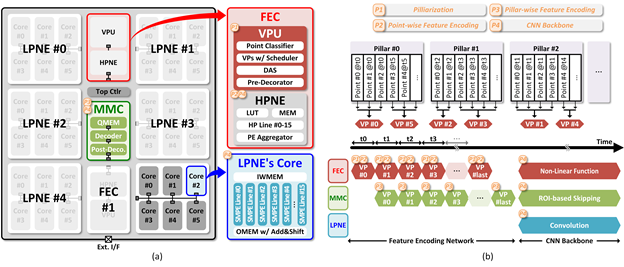Title: A 38.5TOPS/W Point Cloud Neural Network Processor with Virtual Pillar and Quadtree-based Workload Management for Real-Time Outdoor BEV Detection
Venue: CICC 2024
Abstract: A large-scale 3D processing using point cloud neural network (PNN) has become essential for applications such as autonomous driving system. Among the various methods, pillarbased PNN is widely utilized for processing large-scale outdoor environment. However, due to the irregular and sparse nature of point cloud compared to the regular and dense image, achieving high efficiency has been challenging in previous works. Inspired by the LiDAR mechanism that generates point cloud, this article proposes Hawkeye, a large-scale bird’s-eye-view (BEV) detection processor designed for end-to-end processing of pillar-based PNN. Hawkeye incorporates three key features: 1) a feature encoding core (FEC) that introduces virtual pillars, dynamically generating temporal pillars to facilitate continuous processing; 2) a map management core (MMC) that utilizes a quadtree-based workload management system, enabling region-of-interest (ROI)- based skipping to optimize computational efficiency; and 3) a lowprecision neural engine (LPNE) that employs a bit-slice compute architecture with sign-magnitude (SM) representation, enhancing slice-level skipping (SLS) capabilities. Fabricated in Samsung’s 28nm CMOS technology, Hawkeye achieves a performance of 44.2 frames per second (FPS) at 320MHz on the PointPillars with the KITTI dataset. Furthermore, with the aid of ROI-based skipping and SM-based SLS, Hawkeye demonstrates an effective energy efficiency of 38.5 TOPS/W under 0.74V and 40MHz.
Main Figure: